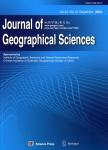Spatial correlations between urbanization and river water pollution in the heavily polluted area of Taihu Lake Basin, China
Spatial correlations between urbanization and river water pollution in the heavily polluted area of Taihu Lake Basin, China作者机构:State Key Laboratory of Lake Science and Environment Nanjing Institute of Geography and Limnology CAS Nanjing 210008 China Scientific Editor White Clay Editorial Newark DE 19711 USA College of Territorial Resources and Tourism Anhui Normal University Wuhu 241003 Anhui China
出 版 物:《Journal of Geographical Sciences》 (地理学报(英文版))
年 卷 期:2013年第23卷第4期
页 面:735-752页
核心收录:
学科分类:12[管理学] 1204[管理学-公共管理] 08[工学] 081303[工学-城市规划与设计(含:风景园林规划与设计)] 0815[工学-水利工程] 0813[工学-建筑学] 0833[工学-城乡规划学] 083302[工学-城乡规划与设计]
基 金:Knowledge Innovation Program of the Chinese Academy of Sciences,No.KZCX2-EW-315 National Water Pollution Control and Management Technology Major Projects,No.20082X07101-002 National Natural Science Foundation of China,No.41130750 135 Strategic Development Planning Project of Nanjing Institute of Geography and Limnology,CAS,No.2012135006 Fund from the State Key Laboratory of Lake Science and Environment,Nanjing Institute of Geography and Limnology,CAS
主 题:urbanization river water pollution spatial correlation heavily polluted area
摘 要:Water pollution in the Taihu Lake Basin has been the focus of attention in China and abroad for a long time, due to its position in the forefront of urban development in China. Based on data gathering and processing from 84 monitoring sections in this heavily polluted area, this study first analyzes spatial patterns of urbanization and the distribution of river water pollution, and then uses the GeoDa bivariate spatial autocorrelation model to investigate the spatial correlation between urbanization and river water pollution at the scale of township units. The results show that urbanization has adverse impacts on water pollution, and the influence varies in different levels of development areas. The urban township units have the highest level of urbanization and highest pollution, but the best water quality; the suburban units have lower level of urbanization, but higher pollution and worse water quality; however the rural units have the lowest level of urbanization and lowest pollution, mainly affected by upstream pollution, but worst water quality. Lastly, urban and rural planning committees, while actively promoting the process of development in the region, should gradually resolve the issue of pollution control lagging behind urban life and urban develop- ment, giving priority to construction of centralized sewage treatment facilities and associated pipeline network coverage in the rural areas and suburban areas.



